Roman Forum Art Story | Location | Opening Hours Tickets | Authorisations
Art Story Mythical Place | Temples Vestals
The Roman Forum, the Mythical Place of Ancient Rome in Italy
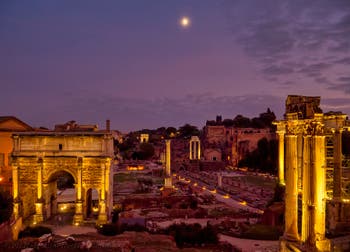
Septimius Severus Arch Concord Temple It is a virtually magical and truly impressive place.
When you walk through the aisles of the Forum one cannot help but feel the past greatness of Rome, one feels so small in the midst of all these remains, works of art and temples, most of which are twice millennia.
Some of these places, such as the Temple and House of the Vestals or the Temple of Caesar, are also moving.
Finally, the climb to Mount Palatine, the tour of which is included in your entrance ticket will give you a superb, unique and complete view of the Forum, but also of Rome nearby.
The Roman Forum: a Village Square
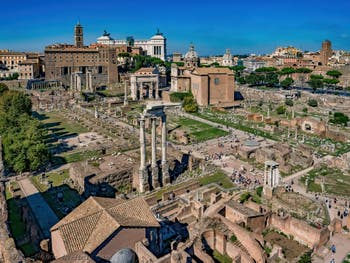
Roman Forum seen from the Palatine Mount The Roman Forum is the ancestor of the village square.
It is located in a flat area between the Palatine and Capitol hills and the slopes of the Quirinal and Viminal.
This land between these hills was flat because it was a marshy area that collected rains from the surrounding mountains.
But because of its perfect position between the various primitive dwelling areas of Rome, shepherds, peasants and merchants still came there to meet and sell their products.
This valley also served as a burial place.
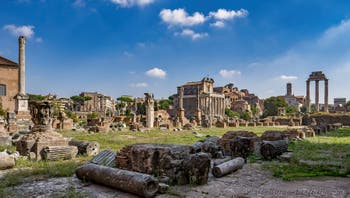
The Roman Forum in Rome in Italy In doing excavations, a necropolis dating from the foundation of Rome was found buried under the Forum.
So many events in the early history of Rome have happened here!
Romulus met there with Tito Tazio, with whom he shared the throne of Rome.
The alliance covenants were also concluded at the Forum, and it seems that the famous Sabine abduction would have taken place there.
The Roman Forum, a simple marketplace that has become the heart of Roman life
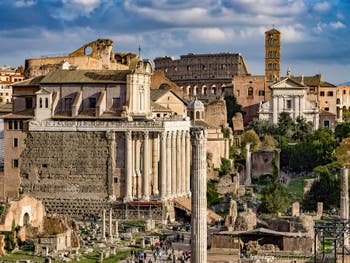
Roman Forum, Antoninus Faustina Temple With the expansion of the city, this village marketplace gradually transformed into a larger commercial area with real shops.
There were various and varied shops: sales of spices and herbs, meats, fabrics, jewellery, etc., but also bankers, an essential element for the trade.
Since the Forum became an important centre for trade and business in Rome, towards the end of the 7th century BC it was decided to dry up this area with stagnant waters by installing a system of underground disposal of waters: the “Cloaca Maxima”.
Rainwater and the Forum swamp were thus discharged directly into the Tiber River.
To dry the place perfectly and compensate for the risk of moisture, the Romans covered the entire surface of the Forum with five metres of sand.
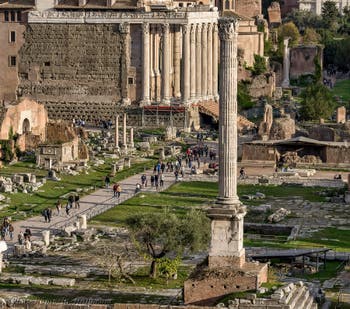
The Foca Column in the Roman Forum In addition, the Roman Forum had been paved, as early as the 7th century BC.
Subsequently, the Forum also became the place where the government met, where decisions were made, voted, enlisted to go to war, come for enumeration, justice, and religious ceremonies began.
The real place, as we know it, in our cities: shops, church, town hall, banks, etc.
The “Comitium” was the central part of the Forum reserved for the elections of judges, political discussions, the posting of notices, the most important religious holidays, public games and all the ceremonies that directly related to the life of the City.
The “Comitium” area is clearly identifiable at the centre of the current Forum.
An official building, the “Curia”, was then built right next to the “Comitium”, to accommodate meetings of the Roman Senate.
The Roman Forum had then become the true heart of Rome.
The Basilicas of the Roman Forum
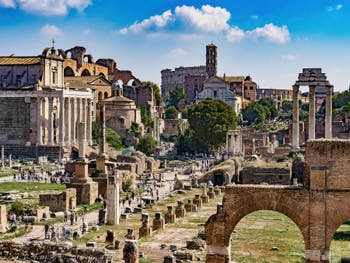
The Roman Forum Temples and ruins All the ceremonies, discussions and celebrations were first in the open air. Subsequently, brick huts were specially built to accommodate them: the “Tabernae”.
Then, given the growing importance of this vital centre of Rome, during the second century BC the construction of the great basilicas of the Forum began.
These were used for public announcements, commercial transactions, but also as courts.
It should be remembered in this respect that the Latin term “Basilica” meaning “tribunal” comes from the Greek “Basilikê” which meant “royal”.
But architecturally, the basilica is a Roman invention.
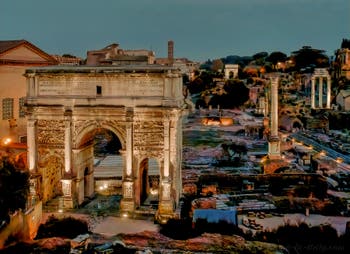
The Roman Forum by night For the Romans, they were large covered buildings, illuminated by windows at the top of a higher central nave, while the interior was divided by colonnades.
These basilicas were not only closed, but also surrounded by long porticoes.
They always had two floors and the main entrance to the building was on the longest side, unlike the Christian basilicas where the entrance is on the shortest side.
Moreover, while for Christians, the meeting place is located inside the basilica, among the Romans, they met outside the basilica.
Finally, while the basilica became a religious place par excellence for Christians, it had no religious character for the Romans who, to do so, had temples corresponding to each of the deities they honoured.
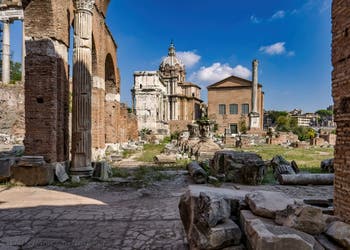
The Roman Forum Temples and ruins Similarly, unlike Christians, in Roman temples, priests were most often inside temples while the faithful stood outside.
Among the great basilicas of the Forum is the Emilian Basilica, built in 197 BC and paid for by the Emilian family, hence its name, one of the richest and most powerful families in Rome at that time.
When all these basilicas were built, the Emilian, but also the Giulia, Porcia, Sempronia, many temples were raised, the sanctuary of Vesta, beavers, protectors of weapons, Saturn, Concord, Venus Cloacina, etc.
Roads were also built linking the Roman Forum directly to the neighbouring districts.
The Forum had become not only a monumental place, but also the heart of Rome's civil and political life.
Via Sacra, the sacred path of the Roman Forum
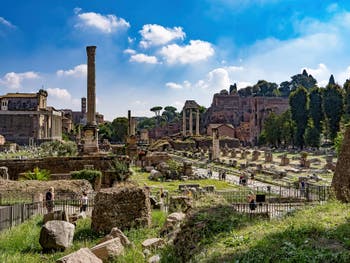
The Roman Forum with the Foca Column The main artery of the Forum was called the sacred way, the “Via Sacra”.
She crossed the Roman Forum along its entire length to climb up to the temple of Jupiter, at the top of the Capitol.
It should be noted that as such, the movement of carts and other vehicles of that time was prohibited within the Forum.
The aisles of the Forum were indeed teeming with people, a crowd far too dense to give way to any vehicle traffic.
All military and religious processions marched on Via Sacra, which begins just in front of the Colosseum to the Temple of Jupiter.
Along this Via Sacra, during the triumphal ceremonies of celebrations of victories, the barbarian kings captured during wars were exhibited, chained and humiliated before the Romans.
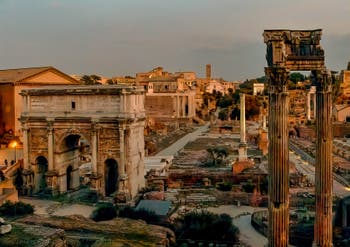
The Via Sacra by night In the year 46 BC, after the Gaul War, Vercingetorix was one of the prisoners humiliated in front of the crowd during Caesar's triumphant parade.
In addition to the victor and the prisoners, there were the legionaries who paraded with the reported loot of the war.
They passed first in front of different temples of Rome, then, after crossing Circus Maxime, they arrived at the Roman Forum, and paraded on Via Sacra passing by the Comitium and the Curia of the Senate.
The final stage of these triumphal parades was the temple of Jupiter Optimus Maximus, where the victorious general was lifted from the vow he had made in the same place before leaving for war.
In this way, the omens of the Gods, the auspices he had accepted from there to fight, found their confirmation.
The Roman Forum marked the point of departure and arrival of Rome's territorial expansion on the world.
Julius Caesar and the Roman Forum
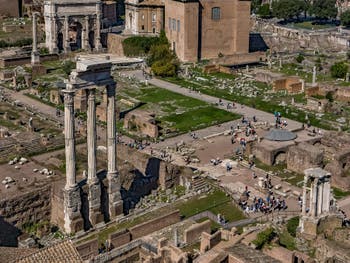
The Via Sacra and Jules Cesar Temple Julius Caesar also initiated a plan for the large-scale restructuring and renovation of the Roman Forum.
A monumental work that was taken over and amplified by the Emperor Augustus.
Of course, Julius Caesar could not guess that the same Forum would also be his grave: after his assassination, his body was transported to the Forum where Emperor Mark Antony pronounced his famous funeral prayer taken over by William Shakespeare.
Next to the sacred way, in front of the temple of the Dioscuri, a stake was erected to burn his body, and the veterans of Caesar's wars threw their swords there.
The Hebrews, of whom Caesar had been the protector by granting them freedom of worship and exempting them from public duties that might contradict their religious beliefs, also came to weep around his corpse in mourning clothes.
Birth of the Living Gods at the Roman Forum
After celebrating Caesar's funeral, Augustus erected a commemorative column and a temple to the “God Caesar”, at the very place of the stake where his body had been burned.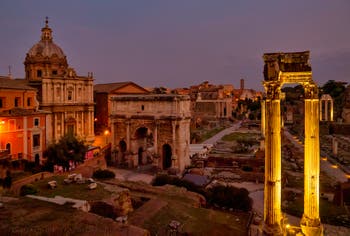
Roman Forum by night This was the first case of post-mortem deification of a Roman ruler.
The temple of Caesar, which is almost at the centre of the Forum, is still honoured today by the Romans.
In addition to March 15, the anniversary of his death, it is not uncommon to see a few bouquets of flowers deposited on what remains of the altar, at the very place where the body was burned.
The emperors who succeeded Augustus continued on this path, and not only for the dead, since they even began to divinize the living.
A way to amplify imperial domination through the creation of a sacred bond between the population and its emperor.
The Emperor Vespasian, the one who builds the Colosseum, and who did not lack humour, told on his deathbed: « I feel that I am becoming a God! »
The madness of greatness was becoming the norm in Rome and among the successors of Augustus began to see, during their lifetime, monumental “divine” equestrian statues of emperors.
Loss of the Forum's political centre role
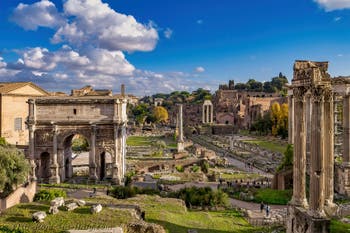
Septimius Severus Triumphal Arch With the development of the Roman Empire, the Forum began to lose its role as the centre of political power, now exercised on Mount Palatine where, from Augustus, the emperors set up their villas and offices that you can also visit.
But that did not mean the end of the importance of the Forum, quite the contrary.
At the same time, the business activities of the Forum were moved to other areas of Rome, including the Forums of Emperors, the “Fori Imperiali”.
Only traders were allowed to continue to exercise their banking activity on the Forum.
From a commercial and political centre, the Forum gradually transformed into a sacred area symbolizing the greatness of Rome.
New temples and basilicas were built, while all the Forum buildings also became more luxurious.
Art Story Mythical Place | Temples Vestals
Roman Forum Art Story | Location | Opening Hours Tickets | Authorisations
Back to Top of Page

